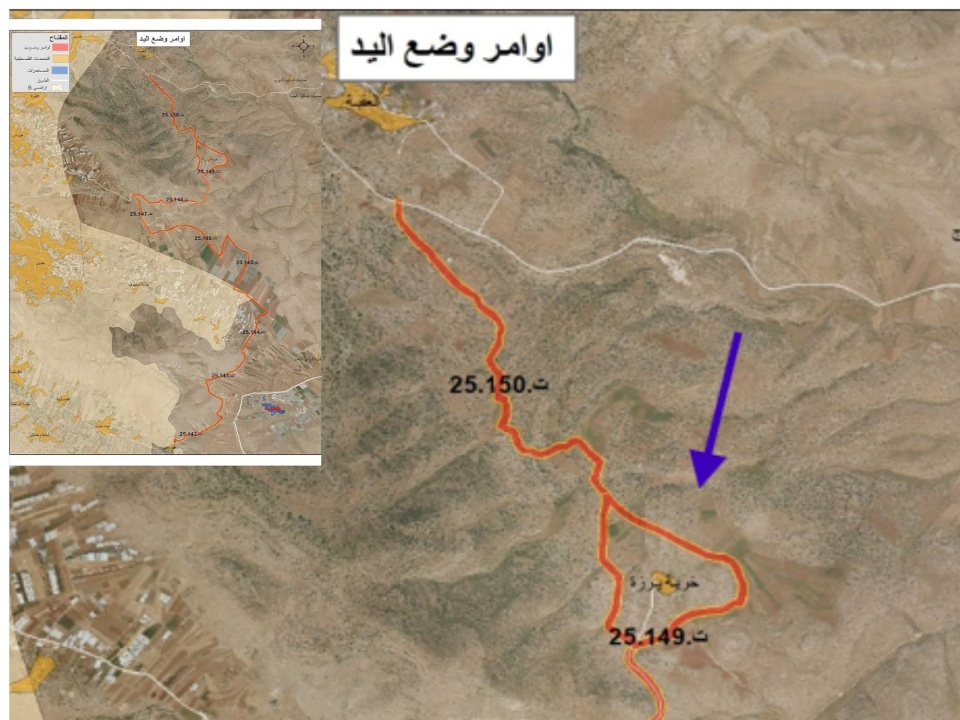
Occupation seizes 1042 dunams of land in Tubas and the Jordan Valley
SadaNews - The Wall and Settlement Resistance Commission revealed that the Israeli occupation authorities have seized a total of 1042 dunams of citizens' lands in the northern Jordan Valley by issuing 9 "provisional custody" orders for military purposes targeting the towns of Tamun, Tyasir, and Talooza, in addition to the city of Tubas. This is aimed at constructing a horizontal road starting from Ein Shibli to the south, reaching Aqaba to the north.
The head of the commission, Mu'ayyad Shaaban, stated that these orders indicate a qualitative shift in the occupation's use of custody orders for military purposes in the Tubas and northern Jordan Valley area. He explained that although 9 orders appear to be separate in terms of numbering and location, the aggregation of their boundaries on the map shows that they collectively form a single project to carve out a wide road extending from northern Tubas toward Tyasir and the Jordan Valley, with a continuous length of 22 kilometers. This road passes through extensive agricultural and residential areas and surrounds Khirbet Yarza east of Tubas from all directions, aiming to deprive citizens from accessing the pastures in the eastern plains, especially to the east of the road, which covers tens of thousands of dunams.
Shaaban noted that "the declared nature of the orders is to carve a security road, a term usually used for bypass roads specific to the army of occupation that allow for rapid control over valley and highland areas, connecting the occupation's bases and points scattered in the Jordan Valley, and securing the movement of settlers in the region later on. In addition, the road's extension as shown on the map indicates that it is not a short-term tactical road, but a strategic passage aiming to create a new movement axis connecting the northern Jordan Valley to the occupied depth, tightening control over the agricultural lands separating Tubas from Tamun and Tyasir, with the goal of thwarting any possibility of a non-directly controlled geographic Palestinian continuity."
He clarified that although the custody orders carry a temporary military nature, experience shows that 90% of "military roads" later transformed into roads serving settlements or separation axes between Palestinian gatherings. He added that the confiscated areas of "about 1042 dunams" are not just a narrow strip; rather, they constitute a wide belt that allows for reshaping the geographical scene in the region, particularly creating a buffer zone between Tubas and the surrounding Bedouin and agricultural gatherings to facilitate the expansion of existing settlements in the Jordan Valley and connect them to a higher-class road network, which represents a blow to the Palestinian agricultural extension that constitutes the backbone of Tubas' economy.
He indicated that the road is located in an area that has seen significant acceleration in the activities and assaults of settlers for two years, reinforcing the hypothesis that the project serves the occupation's vision to deepen the actual annexation of the Jordan Valley and enhance Israeli sovereignty through connected infrastructure.
On the political and legal implications, Shaaban stated that the army's issuance of 9 orders instead of one is a clear attempt to obscure the true scale of the project and avoid political and media uproar. He explained that each separate order appears limited, but when combined, they reveal the picture of a large project that is difficult to pass with a single order without provoking reactions.
He continued: "Here it must be said that relying on a military custody order instead of a civil appropriation order reflects circumvention of international legal obligations and an attempt to present the road as a security necessity rather than a permanent installation. This has become a method followed by the occupying state as it did regarding the street it began to carve out to the east of the town of Jin Safout east of Qalqilya Governorate two years ago, and the order concerning the road construction in the city of Salfit a year ago," noting that these practices represent a clear violation of Article 53 of the Fourth Geneva Convention.
Shaaban added that "the data indicates that we are facing a long-term colonial infrastructure project masquerading as a military facade within the framework of redrawing the geopolitical map of Tubas and the Jordan Valley, creating a strategic longitudinal axis that separates and besieges Palestinian gatherings, enabling settlements, and enhancing their existence at the expense of agricultural lands, which represents a weakening of Palestinians' ability to expand or preserve their threatened lands and imposing new realities that obstruct any future arrangements related to the two-state solution."

Occupation seizes 1042 dunams of land in Tubas and the Jordan Valley

Washington Plans to Confiscate Land from Gaza Residents and Compensate the Owners

Report: Escalation of Settler Terror in the West Bank Amid Clear Official Israeli Complici...

Lebanon: Two Martyrs in Targeting of Two Vehicles and Israeli Airstrikes in Baalbek and th...

Conflicting American Signals: How Does Lebanon's Mission Complicate Against Israel?

Video: 4 Martyrs in an Israeli Airstrike on a Vehicle in Gaza City

Hamas: What the Occupation is Doing in Gaza Constitutes a Flagrant Violation of the Ceasef...

